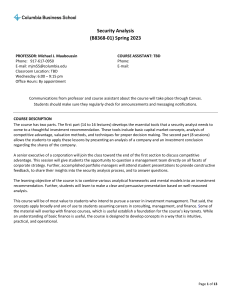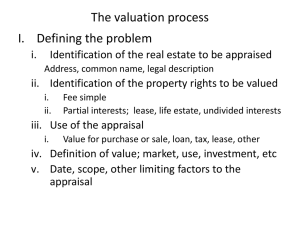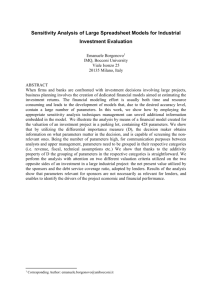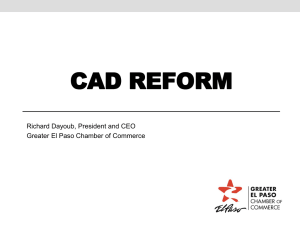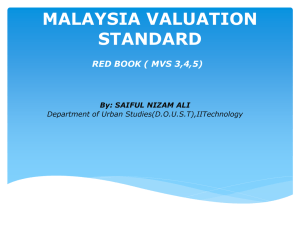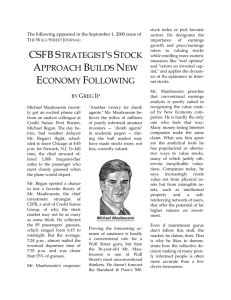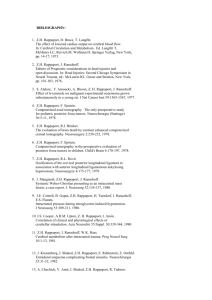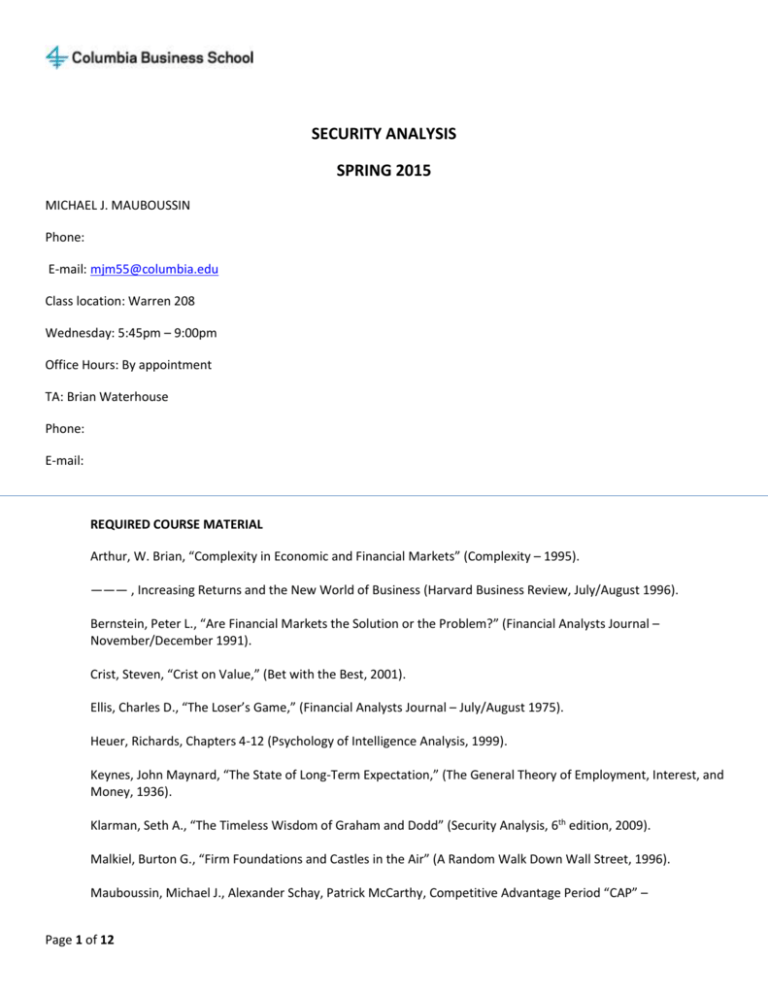
SECURITY ANALYSIS
SPRING 2015
MICHAEL J. MAUBOUSSIN
Phone:
E-mail: mjm55@columbia.edu
Class location: Warren 208
Wednesday: 5:45pm – 9:00pm
Office Hours: By appointment
TA: Brian Waterhouse
Phone:
E-mail:
REQUIRED COURSE MATERIAL
Arthur, W. Brian, “Complexity in Economic and Financial Markets” (Complexity – 1995).
——— , Increasing Returns and the New World of Business (Harvard Business Review, July/August 1996).
Bernstein, Peter L., “Are Financial Markets the Solution or the Problem?” (Financial Analysts Journal –
November/December 1991).
Crist, Steven, “Crist on Value,” (Bet with the Best, 2001).
Ellis, Charles D., “The Loser’s Game,” (Financial Analysts Journal – July/August 1975).
Heuer, Richards, Chapters 4-12 (Psychology of Intelligence Analysis, 1999).
Keynes, John Maynard, “The State of Long-Term Expectation,” (The General Theory of Employment, Interest, and
Money, 1936).
Klarman, Seth A., “The Timeless Wisdom of Graham and Dodd” (Security Analysis, 6th edition, 2009).
Malkiel, Burton G., “Firm Foundations and Castles in the Air” (A Random Walk Down Wall Street, 1996).
Mauboussin, Michael J., Alexander Schay, Patrick McCarthy, Competitive Advantage Period “CAP” –
Page 1 of 12
At the Intersection of Finance and Competitive Strategy, (Credit Suisse First Boston, October 4, 2001).
Mauboussin, Michael J., and Dan Callahan, Measuring the Moat: Assessing the Magnitude and Sustainability of
Value Creation (Credit Suisse, July 16, 2013).
——— , Estimating the Cost of Capital (Credit Suisse, October 8, 2013).
Mauboussin, Michael J., “Revisiting Market Efficiency: The Stock Market as a Complex Adaptive System”
(Journal of Applied Corporate Finance – Winter 2002).
——— , Decision Making for Investors (Legg Mason Capital Management – May 2004).
——— , Common Errors in DCF Models (Legg Mason Capital Management – March 2006).
McTaggart, James M., Peter W. Kontes, Michael C. Mankins, Resource Allocation (The Value Imperative, 1994).
Munger, Charles, A Lesson on Elementary, Worldly Wisdom as it Relates to Investment Management and
Business (USC Business School, 1994).
Porter, Michael E., What is Strategy? (Harvard Business Review, November/December 1996).
Rappaport, Alfred, and Michael J. Mauboussin, “The Case for Expectations Investing,” Chapters 2-3 and 5-8
(Expectations Investing, 2001).
Russo, J. Edward, and Paul J. Schoemaker, Decision Traps and How to Avoid Them (Chemical Engineering, May
1991).
Siegel, Jeremy J., Chapter 1 (Stocks for the Long Run, 4th Edition, 2007).
Treynor , Jack L., “Market Efficiency and the Bean Jar Experiment” (Financial Analysts Journal – May/June 1987).
Tversky, Amos, and Daniel Kahneman, Judgment under Uncertainty: Heuristics and Biases (Science, September
1974).
Williams, John Burr, Preface, Chapter 1-2, 15 (The Theory of Investment Value, 1938)
RECOMMENDED READING
Bernstein, Peter L., Capital Ideas (New York: Free Press, 1992).
——— , Against the Gods: The Remarkable Story of Risk (New York: John Wiley & Sons, 1996).
Besanko, David, David Dranove, Mark Shanley, and Scott Schaefer, Economics of Strategy, 5th ed. (New
York: John Wiley & Sons, 2009).
Page 2 of 12
Ghemewat, Pankaj, Strategy and the Business Landscape, 3rd ed. (Upper Saddle River, NJ: Pearson
Prentice Hall, 2009).
Greenwald, Bruce, Judd Kahn, Paul Sonkin and Michael Van Biema, Value Investing: From Graham to
Buffett and Beyond (New York: John Wiley & Sons, 2001).
Greenwald, Bruce and Judd Kahn, Competition Demystified: A Radically Simplified Approach to Business
Strategy (New York: Portfolio Books, 2005).
Kahneman, Daniel, Thinking, Fast and Slow (New York: Farrar, Straus and Giroux, 2011).
Kaufman, Peter D., ed. Poor Charlie’s Almanack, Expanded Third Edition. (Marceline, MO: Walsworth
Publishing Company, 2008).
Koller, Tim, Marc Goedhart, and David Wessels, Measuring and Managing the Value of Companies, 5th
Edition (New York: John Wiley & Sons, 2010).
Malkiel, Burton G., A Random Walk Down Wall Street: The Time-Tested Strategy for Successful Investing,
Completely Revised and Updated (New York: W.W. Norton & Company, 2011).
Rappaport, Alfred, Creating Shareholder Value: A Guide for Shareholders and Investors (New York: Free
Press, 1998).
Siegel, Jeremy J., Stocks for the Long Run, 4th ed. (New York: McGraw Hill, 2008).
Stewart, III, G. Bennett, The Quest for Value (New York: HarperCollins, 1991).
Surowiecki, James, The Wisdom of Crowds (New York: Doubleday, 2004).
And if you want to make the professor really happy:
Mauboussin, Michael J., More Than You Know: Finding Financial Wisdom in Unconventional Places,
Updated and Expanded (New York: Columbia Business School Publishing, 2008).
——., Think Twice: Harnessing the Power of Counterintuition (Boston, MA: Harvard Business Press,
2009).
——., The Success Equation: Untangling Skill and Luck in Business, Sports, and Investing (Boston, MA:
Harvard Business Review Press, 2012).
Here are some websites you might find useful:
http://pages.stern.nyu.edu/~adamodar/
www.expectationsinvesting.com
www.michaelmauboussin.com
Page 3 of 12
PREREQUISITES AND CONNECTION TO THE CORE
The learning in this course will utilize, build on, and extend concepts covered in the following
core courses:
Core Course
Corporate Finance
Connection with Core
1. Cost of capital
2. Valuation
3. Financing options
4. Time value of money
5. The capital asset pricing model (CAPM)
6. Real options
7. Firm valuation model
Financial Accounting
1. The “accounting equation”
2. Revenue and expense recognition
3. Resources and obligations – measurement and disclosure
Global Economic
1. Risk management
Environment
2. What is Gross Domestic Product and how is it measured?
3. What causes inflation?
4. What causes changes in exchange rates?
5. What are the causes of business cycles?
6. What are the effects of monetary policy?
7. What are the effects of fiscal policy?
8. What is the role of financial markets in the economy?
Managerial Economics
1. Barriers to entry
2. Moats
3. Maximization and thinking on the margin
4. Analyzing complex decision making under uncertainty
5. Decision-based cost analysis
6. Pricing with market power
7. Market segmentation and other advanced pricing strategies
8. Understanding market competition and equilibrium thinking (in the
short run)
9. Market equilibrium thinking (in the long run) and barriers to entry
10. Strategic interaction among firms and Nash equilibrium
Strategy Formulation
1. Trade-offs, value-added, efficiencies
2. Creation of value vs. value capture
3. Competing firms
4. Co-opetition and complementors
5. Strategic interaction analysis
6. Diversification and scope
7. Ethics & IBS
8. Behavioral and evidence-based strategy
9. Management
Students will be expected to have mastered these concepts and be able to apply them in the course.
Page 4 of 12
COURSE DESCRIPTION
55% lecture
35% student presentations
10% company/student interaction
The course has two parts. The first part (14 to 16 lectures) develops the essential tools that a security
analyst needs, including basic capital market concepts, competitive analysis, valuation methods, and
techniques for proper decision making. The second part (8 sessions) allows the students to apply the
lessons they have learned by presenting a thorough analysis of a company and an investment conclusion
regarding the shares of the company.
A representative of a major corporation will join the class near the end of the first section. This session
will give students the opportunity to question a management team directly on all facets of corporate
strategy. Further, accomplished portfolio managers will be invited to attend student presentations to
provide constructive feedback, share their insights into the security analysis process, and answer
questions.
A key skill for an analyst is to be able to clearly and persuasively make a case for the purchase or the sale
of a particular security based on well-reasoned analysis. To make all class presentations more realistic,
the class will participate by acting as portfolio managers. Further, following each presentation, each
student will elect whether or not to follow the investment recommendation of the presenting group.
The course prerequisite is (B6302) Capital Markets. Early in the semester, some of the material will
overlap with finance courses. You can view this material as the opposite side of the same coin, and it is
intended to firmly establish a foundation for the course’s key tenets. While an understanding of basic
finance is important, the course is designed to develop concepts in a way that is intuitive, practical, and
operational.
Columbia Business School has a terrific tradition of teaching security analysis. This course, at its best, is
both practically oriented and intellectually stimulating. Two quotes sum up the proper attitude going
into this course. The first is nullius in verba, which means “take nobody’s word for it; see for yourself.”
Security analysis is not a science (although a few of the tenets are reasonably well established) and we
have a lot to learn. You must always actively seek to better understand the process, and you can be
assured no one is going to offer you the answers. The second quote is non notationes, sed notions,
which translates to “not notations, but notions.” Corporate finance is too often taught by laying out
formulas, without enough consideration of what those formulas mean (or were meant to explain). We
should all do our best to perpetuate the fine tradition of security analysis at CBS.
Page 5 of 12
COURSE OBJECTIVES
The goal of this course is to develop a thought process for equity security analysis based on four building
blocks:
(1) Capital markets
- What factors drive market value and how do we understand and analyze them?
- Are markets efficient? If so, why? If not, why not?
- Does modern portfolio theory best explain markets?
- Does intrinsic value or market psychology determine stock prices?
- Can study of complex systems provide useful insight into markets?
(2) Valuation
- How do you value a business?
- Which of the common analytical tools tells you the most about value?
- What does the stock market say about corporate performance?
- How do you incorporate risk into the value calculation?
- How do you capture competitive advantage in your valuation?
- Is there a legitimate distinction between value and growth investing?
(3) Competitive Strategy
- What is the definition of a good business?
- How do you evaluate industry factors?
- How do you isolate company-specific sources of value creation?
- What is role of firm interaction?
- Does the shift from physical to knowledge assets require new strategy models?
(4) Decision Making
- What do successful players in probabilistic fields have in common?
- How do we misspecify probabilities and outcomes?
- Can self-awareness negate personal biases?
- How can we link cognition and economics?
We will consider answers to these questions in the context of a highly competitive market, and will
combine practical tools and theoretical approaches.
Page 6 of 12
ASSIGNMENTS
Class
1 and 2
Date
28-January
Materials We Will Cover and Your Assignment
· Introduction and Overview
· Illuminating Exercises
· Groundwork
Core readings:
Klarman, The Timeless Wisdom of Graham and Dodd
Crist, Crist on Value
Keynes, The State of Long-Term Expectation
3 and 4
4-February
· Market Myths and Realities
· Market Efficiency
· Market as a Complex Adaptive System
· Selection of Groups for Final Reports
Core readings:
Siegel, Stock and Bond Returns
Rappaport and Mauboussin, Chapter 1
Treynor, Market Efficiency and the Bean Jar Experiment
Ellis, The Loser's Game
Bernstein, Are the Markets the Solution or the Problem?
Mauboussin, Revisiting Market Efficiency
Arthur, Complexity in Economic and Financial Markets
Additional readings:
Mauboussin, Capital Ideas Revisited Parts I and II
5 and 6
11-February
· Valuation Concepts
· Review of Techniques
· Selection of Stocks for Final Reports
Core readings:
Williams, Theory of Investment Value
Rappaport and Mauboussin, Chapters 2, 3, 5, 6, 7, 8
Mauboussin and Callahan, Estimating the Cost of Capital
Mauboussin et al., Competitive Advantage Period (CAP)
7 and 8
Page 7 of 12
18-February
· Valuation Concepts
· Competitive Advantage and Valuation
· Expectations Investing
· Case Study
Additional readings:
Mauboussin, Common Errors in DCF Models
9 and 10
25-February
· Competitive Strategy Framework
· Capital Allocation Decisions
· Valuation Papers Due
· Preparation for Management
Core readings:
Mauboussin, Measuring the Moat
Porter, What is Strategy?
Rappaport and Mauboussin, Chapters 4 and 9
McTaggart, Kontes, Mankins, Resource Allocation
11 and 12
13 and 14
4-March
Company Presentation
TBD
11-March
NO CLASS
18-March
NO CLASS
25-March
· Decision Making
· Strategy Papers Due
Core readings:
Tversky and Kahneman, Judgment Under Uncertainty
Heuer, Psychology of Intelligence Analysis
Mauboussin, Decision Making for Investors
Russo, Shoemaker, Decision Traps and How to Avoid Them
Munger, A Lesson on Elementary, Worldly Wisdom
15 and 16
1-April
· Other Analytical Tools (M&A, real options, TAM, customer economics)
· Open ended Q&A
· Presentation tips
17 and 18
8-April
· Presentations
Guest: TBD
TBD
19 and 20
15-April
· Presentations
Guest: TBD
TBD
Page 8 of 12
21 and 22
22-April
· Presentations
Guest: TBD
TBD
23 and 24
29-April
· Presentations
Guest: TBD
TBD
TBD
· FINAL PAPERS DUE
METHOD OF EVALUATION
Company basic report
Presentation of basic reports
Valuation exercise
Strategic assessment
Three one-page reports
Class participation
30%
20%
15%
15%
10%
10%
Grades for the course will be based on 6 factors, as follows:
1. Company basic report. The maximum length of the report is 10 pages, excluding exhibits. We will
discuss the format and content of the report in more detail in class. These reports are done on a group
basis (Type A), although a mechanism will be in place to assure that contributions are equal among
members. This report is due one week after our last class meeting. (30%)
2. Presentation of basic reports. Everyone will be required to participate in the presentation. (20%)
3. Valuation exercise. Students will be required to complete a valuation exercise (details in class). This
project is to be completed individually (Type C). Due one week after assigned. (15%)
4. Strategic assessment of the company based on our corporate presentation. The paper should be
approximately five (5) pages with 1.5 spacing, and does not require valuation work. This project is to be
completed individually (Type C). Due one week after assigned. (15%)
5. Three one-page reports on companies presented in class. These papers are due one week after the
presentation in class. Two copies of the report should be handed in, so that a copy can go to the
presenting group for feedback. This is to be completed individually (Type C).
(10%)
6. Class participation. All aspects of the course—including the initial lectures—are intended to be
interactive.
Page 9 of 12
Students are encouraged to challenge, disagree, and pose alternate views. Further, attendance will be
taken every class, with the cumulative attendance record contributing to a class participation grade.
(10%)
(1) Basic reports. Students will work in groups of four on the basic reports. The professor will provide a
list of companies that the groups will analyze—one group per company. Students will make a
presentation to the class and hand in the full report on or before May 7, 2014. The order of the
presentations will be determined within the first few weeks of the course, and will depend in part on the
schedules of the professional guests critiquing the presentations. Portfolio manager comments will not
be considered in the grading process, and are intended for student edification only.
(2) Valuation project. This exercise is intended to give all students an opportunity to explore the key
thought processes and mechanics behind valuation.
(3) Write-up of company presentation. Students are expected to assess the competitive position, key
value drivers, central strategies (both operating and financial), and management of the presenting
company. Well thought-out conclusions, appropriate prioritization of key issues, and rigorous and
consistent analysis are the central objectives of this paper.
(4) One-page reports. The one-page reports will be done individually and will be due at the start of the
class following the week of the presentation. The write-ups should focus on an evaluation of the
information and should present an independent recommendation for the company's shares (with an
explanation). Do not recap what was said in class. Each student must select three cases to write up.
(5) Presentation of reports. Consistent with the theme of practical skill development, you will be graded
on the verbal presentation as well as the written report. Emphasis should be placed on the clear
conveyance of well thought-out conclusions. Other students are expected to actively participate in the
Q&A period following each presentation, and will be graded on their questions and comments.
Page 10 of 12
Grade Rubrics:
Valuation
This project is to be completed on an individual basis.
H
* Correct answers
* Work is shown
* Answers are organized
HP
*Partially correct answers
*Work is shown
*Answers are organized
≤P
*Incorrect answers
*Work is not shown
*Answers are disorganized
Competitive strategy
This project is to be completed on an individual basis.
H
HP
≤P
* Does not regurgitate known facts
* Effective use of strategy frameworks
* Clear summary with conclusion
stated
* Well organized
* Stays within specified length
* Free of typos
* Some discussion of known facts
* Competent use of frameworks
* Substantial recap of known facts
* Little/poor use of frameworks
* Summary does not state conclusion
* Decently organized
* Stays close to specified length
* Some typos
* Conclusion poorly articulated
* Poorly organized
* Deviates from specified length
* Lots of typos
Presentation to portfolio manager
This presentation is to be completed as a group, although you will be assessed both individually and as a
group.
H
Group Level
* Strong intro/company description
* Prioritized operating assessment
* Relevant financial assessment
* Thorough valuation
* Analysis strongly supports
conclusion
* Within time limit (12 minutes)
Individual Level
* Looks and acts highly professional
* Highly organized
* Conveys ideas very clearly
* Comments are well substantiated
* Contribution is equal
Page 11 of 12
HP
≤P
* Average intro
* Solid operating assessment
* Average financial assessment
* Solid valuation
* Weak intro/company description
* Poorly prioritized or no operating assessment
* Weak or lacking financial assessment
* Sloppy or incomplete valuation
* Analysis backs conclusion
* Near time limit
* Analysis doesn't support conclusion
* Over time limit
* Looks and acts professional
* Well organized
* Conveys ideas well
* Comments are supported
* Contribution is close to equal
* Does not appear professional
* Disorganized
* Poorly conveys ideas
* Comments are unsubstantiated
* Unequal contribution
One page summaries of other group presentations
These are to be completed on an individual basis.
√+
* Does not simply recap presentation
* Clearly explains basis for agreement or disagreement
* Highlights key facts behind reviewer decision
* Articulates presentation’s strengths/weaknesses
√
* Presentation recap
* No clear view explained
* Does not prioritize salient issues
* Fails to explore presentation effectiveness
Final paper
The final paper is a group effort.
H
* Clear summary and recommendation
* Effective company description
* Discussion of relevant recent activity
* Well-structured operating discussion
* Effective financial assessment
HP
* Solid summary
* Acceptable company description
* Recent activity discussed
* Solid operating discussion
* Partial discussion of financials
* Proper discussion of management
* Valuation, incl. multiple approaches
* Some management discussion
* Some valuation work
* Includes some recommended
tables
* Average presentation and editing
* Good use of graphics
* Includes all recommended tables
* Well-presented and edited
* Effective use of graphics
≤P
* Poor summary
* Poor company description
* Recent developments ignored
* Poor operating assessment
* Weak financial assessment
* Managerial assessment
overlooked
* Weak valuation
* Includes few recommended tables
* Poor presentation and editing
* Weak use of graphics
CLASSROOM NORMS AND EXPECTATIONS
You must hand in all papers on the assigned due date (unless you make arrangements ahead of time).
Any student who hands work in late will not receive a top grade.
Attendance will be taken every class, with the cumulative attendance record contributing to a class
participation grade.
Use of laptops should be restricted to taking notes.
Please inform professor or TA of any anticipated or unanticipated absence.
Page 12 of 12

